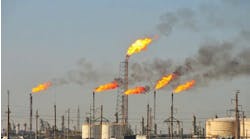Dan Hebert is senior technical editor for Control, Control Design and Industrial Networking.
The Earth rotates, so any movement in the Northern hemisphere is diverted to the right and any movement in the Southern hemisphere is bent to the left. This apparent bending force is known as the Coriolis force, and is named after the French mathematician Gustave Gaspard Coriolis (1792-1843).
Since the 1970s, instrument designers have used the principle of Coriolis force to measure mass flow and density with Coriolis flowmeters. Most of these meters also include temperature measurement and are thus true multivariable instruments.
Read Also: Coriolis for the Masses
A traditional method for measuring viscosity with mass flowmeters is to add a differential pressure (DP) meter. Viscosity is the measure of a fluid's internal or intermolecular resistance to shear stress. Certain types of fluids offer greater resistance to velocity than others. Tar or syrup cannot be poured easily and have high viscosities. Water or gasoline are "thinner" and have much lower viscosities.
A DP meter can be installed around the mass flowmeter with taps upstream and downstream. Viscosity is measured by determining the pressure drop through the mass flowmeter. The viscosity of the flowing medium is directly proportional to the ratio of pressure drop and volumetric flow rate. This calculation of viscosity is based on the Hagen-Poiseuille equation and is expressed as absolute viscosity.
Viscosity measurements with Coriolis and DP have some limitations in addition to the obvious cost of two separate meters. The Hagen-Poiseuille equation is only valid for laminar flows with a Reynolds number less than 2,000. This often forces the use of larger and more expensive meters to minimize flow velocity. The flow profile must be uniform throughout the DP measurement section of the process, and the Hagen-Poiseuille equation is also only theoretically valid for Newtonian fluids.
These limitations have spurred research into methods of measuring viscosity directly with a Coriolis meter. Research at Endress+Hauser has resulted in the recent introduction of direct viscosity measurement in the company's Promass 83 I line.
Coriolis flowmeters measure the rotational force exerted by fluids flowing through an oscillating measurement tube. Measurement of these forces is used to calculate mass flow and density. Endress+Hauser uses the torsional movement of the single straight measuring tube to additionally measure the viscosity of the fluid.
Read Also: How Do Coriolis Flowmeters Work?
Promass Coriolis flowmeters use a patented torsion mode balance system for optimum balance and isolation from external influences. A pendulum is attached to the middle of the oscillating measuring tube to provide a balancing force. This pendulum oscillates counterphase to the tube, thus compensating for the momentum of the measuring tube.
Due to the rotational motion of the tube, the fluid is forced to a rotational motion. Depending on the fluid's viscosity, different velocity profiles of the fluid are generated. The gradient of the velocity profile induces shear forces in the fluid, which dampen the oscillation of the measuring tube and can be measured via the excitation current necessary to maintain tube oscillation. The excitation current can then be used to calculate the viscosity of the fluid.
The accuracy of viscosity measured with this patented method depends on whether the fluid is Newtonian or non-Newtonian. The viscosity of Newtonian fluids is independent of shear rate. Water is a Newtonian fluid, so its viscosity is not affected by shear rate. Stated differently, water will pour out of a container at the same rate if the water is still or if the water is being stirred.
The viscosity of Newtonian fluids can be measured with a high rate of repeatability and reasonable accuracy. "The total accuracy equals ±5% of reading and the repeatability is 0.5% of reading," according to Stefan Grotzer, flow product manager, Endress+Hauser.
If the viscosity changes with shear rate, the fluid is non-Newtonian. The effect of shear rate depends on the type of fluid--some non-Newtonian fluids have a reduced viscosity when shear rate is high, some the opposite effect (increased viscosity with higher shear rate). Ketchup is a good example of the former: it is usually necessary to shake the ketchup bottle to induce flow. This shaking or shearing reduces the ketchup's viscosity and promotes flow.
The accuracy of viscosity measurements for non-Newtonian fluids is adversely affected by shear rates generated by the Coriolis meter and by other elements. However, Coriolis meters can measure the viscosity of non-Newtonian fluids with good repeatability.
Coriolis meter viscosity measurement of non-Newtonian fluids is typically used where the target is a repeatable measurement and where continuous correlation to a lab measurement is not required. A change in viscosity can be an indication of a process problem, or can indicate the product is outside the acceptable limits of viscosity.


